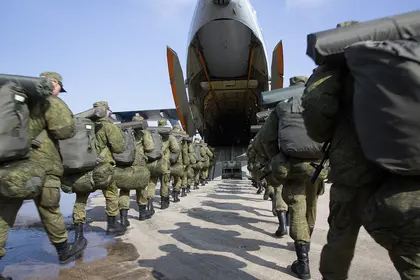The Security Service of Ukraine, or SBU, has identified at least 40 Ukrainian nationals fighting for Russia’s Wagner private military company – a Kremlin-sponsored mercenary group that fought in Russia’s war against Ukraine and now fights to support Syrian dictator Bashar al-Assad.
Some of them are no longer alive, however.
Igor Guskov, the chief of staff of the head of SBU, told the Kyiv Post that at least three Ukrainian nationals were killed in Syria in the spring of 2016, while more are likely to have been killed in a Feb. 7 airstrike by U.S. forces in Syria.
He said that the SBU has information that several residents of Crimea, the Russian-occupied Ukrainian peninsula, were among nearly 300 mercenaries killed on Feb. 7 in U.S. air and artillery strikes in Deir al-Zour province in eastern Syria.
The Russian mercenaries were reportedly attempting to capture a base held by anti-Assad forces when their advancing troop columns were hit by U.S. airstrikes.
Guskov said that Wagner company had a special unit called the Carpathians, which formerly had about 100 Ukrainian and Russian nationals. The unit was formed in 2015 in the Russian-occupied parts of Ukraine’s Donbas.
“They were initially trained for subversive and terrorist activity in Ukraine,” he said.
He added that after Russia deployed its mercenaries to Syria, the Ukrainians were dispersed among various Wagner units.
Guskov said Wagner mercenaries were the main force used by the Russians to capture the Syrian city of Palmyra in March 2016 and March 2017 – operations that brought them heavy casualties.
According to SBU information published by the Ukrainian Service of Radio Free Europe/Radio Liberty, the three Ukrainian nationals killed in Syria in spring 2016 were Donetsk Oblast natives Eduard Prykhodko from Horlivka, Oleksandr Konashenkov from Novohradivka, and Oleksandr Kyyashko from the city of Donetsk.
The first two were killed near Palmyra and the third in Latakia. All three had previously fought for the Russian side in the Donbas.
Wagner founder
While Moscow has dissociated itself from Wagner, Dmitry Utkin, the founder and leader of the mercenary group has been spotted by media at an official reception in the Kremlin, and he has been photographed with Russian President Vladimir Putin.
Utkin, a former officer of Russia’s GRU military intelligence agency, grew up in Ukraine and went to school in the town of Smoline in Kirovohrad Oblast, where his mother lived until recently.
Utkin traveled to Ukraine for the last time in 2013, according to the SBU.
In June, the United States put Utkin on its sanctions list for his involvement in the war in Ukraine.
Earlier, SBU head Vasyl Hrytsak said that the Wagner group was responsible for downing a Ukrainian IL-76 military jet with 49 Ukrainian soldiers onboard near Luhansk Airport in June 2014.
Cannon fodder
Russian mercenary Mikhail Polinkov, who fought in Russia’s war against Ukraine, said in an interview with Roy-TV, a Russian ultranationalist Youtube channel, that the Carpathians unit, also known as Vesna (Spring), was one of three main forces in Wagner group’s attack on Feb. 7, and that 94 of its people were killed.
“They were the attacking core,” Polinkov said. “They went first — the Carpathians-Spring. I don’t know why, but they were always being sent into the attack first as cannon fodder. And they were also paid less than the others,” he said.
Polinkov said in the interview that he had visited some of the Wagner mercenaries in Moscow hospitals.
According to Russian media reports, Wagner’s mercenaries are paid some 24,000 rubles (about $4,000) a month, while the families of those killed receive 5 million rubles (about $88,000) in compensation.
Slain Wagner mercenaries receive no benefits from the Russian government, but have had monuments raised in their honor in Russian-occupied parts of eastern Ukraine and in the parts of Syria controlled by the Assad regime.
Donetsk-born journalist and blogger Denis Kazansky recently posted on his Facebook page photos of two identical monuments to Russian mercenaries, both monuments having recently been unveiled in the Russian-occupied city of Luhansk, and in Syria.
The figures on the monuments are wearing the special medals that Russia has awarded to Wagner mercenaries.
Mercenaries identified
Ukrainian online investigators have also uncovered the names and photographs of mercenaries.
Activists from the open-source intelligence groups InformNapalm and Ikhtamnet_m0209, as well as the Ukrainian Cyber Alliance hacker group, have identified 25 Wagner mercenaries who fought in a Russian tank unit, and 20 members of a Wagner group howitzer battery.
InformNapalm published their photos, military credentials, and names, and also claimed that the commander of the tank unit – Russian citizen Sergey Kim, a former marine officer – planned the failed Wagner attack on the base in Syria on Feb. 7.
The identified Ukrainian nationals include Oleksandr Bohadyr, born in Mariupol, who serves as an artillery commander, and Andriy Chemerys from Crimea, who is a gunner with a Wagner tank company.
“We didn’t manage to find out if (the 25 tank unit fighters) actually took part in the battle near Deir-az-Zor,” reads a message posted on the activists’ website. “But many of them have Russian military awards for taking part in the war in the Donbas – in particular, for the battle for Luhansk Airport (in 2014).”
The Ukrainian activists said the Wagner mercenaries are now instructed not to leave traces in social media, and indeed they left less information about themselves than other Russian army soldiers, who post numerous photos from the war in Ukraine’s Donbas in Russian social media Vkontakte and Odnoklassniki.
The full list of identified Wagner mercenaries can be found here.
You can also highlight the text and press Ctrl + Enter





